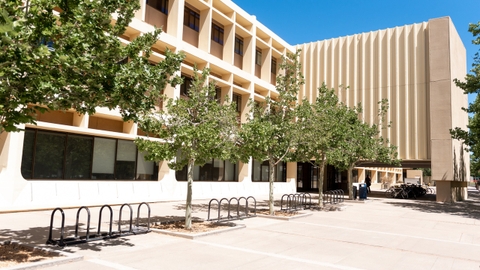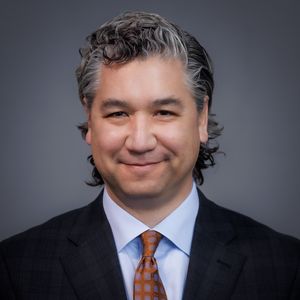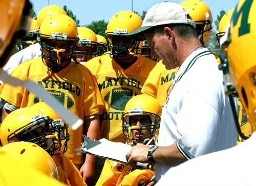Making a Comeback – How a UNM Brain Specialist Helps a NM Football Coach and Others with Long COVID Get Back in Game



State Agency Press Release – From the University of New Mexico School of Medicine Communications
By Jill Rothenberg | May 19, 2025
Las Cruces football coach Michael Bradley led the Mayfield High School Trojans to numerous state championships over the course of his 32-year career.
As a runner and weightlifter with a strict schedule and workout routine, he demanded as much from himself as he did from his players. Bradley even brought his elliptical machine home for workouts when the COVID-19 pandemic began.
“I got on that thing every day for an hour,” he said. But in September 2021 Bradley came down with COVID, and his lifelong exercise routine was upended. Although he recovered from the initial infection, he was left with lingering Long COVID symptoms, including brain fog, memory and recall problems and sleep disturbances.

Three-and-a-half years later, Bradley is receiving cutting-edge care from Davin Quinn, MD, FACLP, a professor in The University of New Mexico’s Department of Psychiatry & Behavioral Sciences, who is one of a small group of clinicians in the country who are board-certified in adult psychiatry, consultation psychiatry, behavioral neurology and brain injury medicine.
“Everyone’s got a different experience of the COVID infection and then their recovery from it,” said Quinn, who is also vice chair of Adult Clinical Services and served as principal investigator on a 2022 UNM study on the effects of Long COVID on the brain.
It has been estimated that 400 million people worldwide have been diagnosed with some form of Long COVID. In 2021, UNM joined two large National Institutes of Health-funded studies of patients through the RECOVER (Researching COVID to Enhance Recovery) Initiative whose findings help UNM clinicians tailor treatment plans for their patients with symptoms.
Quinn’s research on Long COVID and the role of inflammation in causing one of its common symptoms – “brain fog” – is a collaboration with Andrei Vakhtin, PhD, a cognitive neuroscientist who uses imaging techniques to study Long COVID at the Mind Research Network, and Alisha Parada, MD, co-PI of UNM’s RECOVER study and medical director of the Long COVID clinic at UNM Hospital.
Quinn, who is also co-director for the UNM Center for Brain Recovery and Repair Clinical Core, conducts research in the use of transcranial magnetic stimulation (TMS) – a non-invasive technique that generates electromagnetic fields to stimulate nerve cells in the brain. Researchers use TMS to understand how regions of the brain are affected by conditions like concussion, depression and Long COVID, and to treat their symptoms: problems with attention, memory, problem-solving and others.
He has launched a new study that uses TMS to treat Long COVID patients who have these kinds of symptoms to better understand the role of microglia, cells that are responsible for the immune response inside the brain, and specifically how their activity in creating or reducing inflammation is related to the characteristic fatigue, cognitive problems and sensory problems.
“COVID made me really cloudy in the head.” – Michael Bradley

Michael Bradley first saw Quinn for the lingering and often debilitating Long COVID symptoms in 2022. He experienced pain and unusual sensations in his head, “like my head was going to explode,” he said. This was accompanied by difficulty organizing things and remembering things that he did or that he was told and being more easily confused and frustrated, he said.
Coach Michael Bradley with Team.
Bradley had become isolated in his home and was very sick when he had COVID, he said. “It made me really cloudy in the head.” When he returned to coaching full-time a couple weeks later, he would come home, collapse and sleep, he said.
But after recovering from the acute infection, he discovered that he got relief from a most unexpected source: his old friend the elliptical.
While many people with Long COVID experience post-exertional malaise, where physical or mental exertion leads to a worsening of symptoms, Bradley said that his slow return to exercise made him feel better.
“When I got off after an hour on the elliptical, I would go out on the back patio and do some lifting,” he said. “After that, I felt great. I was just clearer.”
The more common story for many Long COVID patients is that they get easily fatigued by exercise, Quinn said, adding that a gradual and safe return to exercise after being sick with the virus can help patients feel better.
“What a lot of research on COVID suggests is that people get deconditioned when they’re sick,” he said. “After just two weeks of sitting around, they can get deconditioned and don’t realize it until they start going through a structured exercise program that gets them going. And then they do feel better with the exercise.”
But he added that the relief and clarity that Michael Bradley gets from exercise may indicate a different kind of phenomenon, where exercise temporarily normalizes what is
going on in the brain. But then when it’s stopped, the symptoms of brain fog and cloudiness return.
“This speaks to something vascular and has to do with how blood and nutrients and oxygen are getting to your brain when you’re exercising versus when you’re not,” Quinn said. “And something about exercise does a better job delivering what your brain needs. The fog lifts during that time. Then, when you stop your autonomic system cycles back down, that’s when you feel worse again.”
Whether exercise makes one person with Long COVID feel better or causes crushing fatigue and exertional malaise in another, in both cases, it still proves the point that exercise is medicine for the brain, Quinn said. But for people who have been lifelong or competitive athletes like Michael Bradley, it can be challenging to work with them to tailor a Long COVID treatment plan that includes a pharmaceutical drug or even a non-prescription nutraceutical, which is a dietary supplement that can address symptoms like fatigue, brain fog and inflammation.
“I can work with them to do other non-pharmaceutical, non-prescribed things,” Quinn said. “But I can also see that some people are suffering, and I know that certain medications could help them a lot. Once they start getting on a path with improvement, that gives them a bit more hope. They start having small, successful steps and start to feel better, and don’t need the treatments as much and understand that it’s not going to be a forever thing.”
It’s been a long road back to recovery for Michael Bradley, who wasn’t used to sitting still and whose dad, a longtime Mayfield High School and New Mexico State University football coach, instilled in him a love of football and daily exercise.
“I’ve exercised throughout my life, whether it was in my garage, out running, or at the racquetball club,” said Bradley of his twelve-hour days and long weekends as a football coach. But COVID forced him to change his routine, to rest, and to not exercise as vigorously.
Quinn prescribed him a regimen that includes low-dose naltrexone and methylphenidate (better known as Ritalin), a stimulant most often used to treat ADHD.
“Naltrexone is an opioid receptor antagonist at higher doses, but at lower doses it has immunomodulatory or anti-inflammatory effects and can treat conditions where there’s an inflammatory component, like multiple sclerosis and chronic fatigues,” he said.
“My colleagues and I have been recommending patients try it with the idea that there’s something about your immune system that got revved up by the COVID infection. Even though the infection cleared and there’s no more virus, the immune response is still ongoing. And so perhaps by using low-dose naltrexone, it’s able to calm down that immune response.”
There has also been research that supports the use of methylphenidate to improve attention and focus and combat the brain fog that often accompanies Long COVID, Quinn said.
These prescribed medications are often combined with the nutraceuticals N-acetyl-L-cysteine and diamine oxidase, as well famotidine, an antihistamine whose common brand names include Pepcid and Zantac. Taken together, they can reduce inflammation, fatigue and brain fog.
Naltrexone and methylphenidate play an important part of Michael Bradley’s treatment plan for Long COVID symptoms. So do exercise and reducing stress.
Taking walks through his pecan orchard with the dogs, going to the lake and living an active retirement – while replacing his well-worn elliptical – is what Bradley has in his game plan.
“Just keep moving forward,” he said. “Don’t sit around. Find something you enjoy and do it. It’s important to keep moving. A lot of people have it worse than you do.”